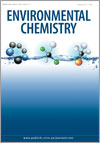Environmental context. Organic phosphorus can be one of the major fractions of phosphorus in many aquatic ecosystems. This paper discusses the distribution, cycling and ecological significance of five major classes of organic P in the environment and discusses several principles to guide organic P research into the future.
EN13151 Abstract | EN13151 Full Text | EN13151PDF (515 KB) Open Access Article




